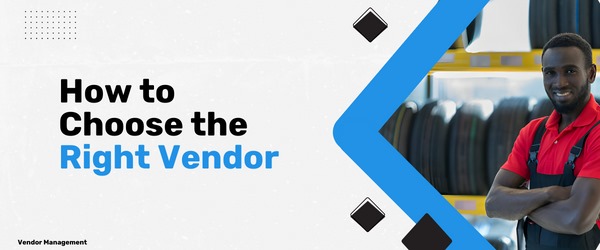Table of Contents
Have you ever wondered what the cornerstone of effective facility management is? Beyond the obvious elements like streamlined operations, automation, maintenance schedules, or even energy management, there’s a critical component often overlooked: the vendor selection process.
If we can all agree that facility, fleet, and asset management play pivotal roles in operational efficiency, then choosing the right vendor can also greatly affect the overall operational efficiency of the organization. It could mean the success and failure of the facility management team as a whole.
So, Why is this process so crucial?
Well, for starters, the right vendor brings more than just a product or service; they bring expertise, reliability, and innovation.
Most facility managers have had an experience or two of a vendor falling short of expectations, causing delays, or worse, compromising safety? Situations like this for a facility management team aren’t just inconveniences; they can have far-reaching implications.
The right vendor acts as an extension of your team, understanding the nuances of your operations and proactively contributing to your goals.
But how do you navigate the stages of vendor selection without falling into conflicts of interest or bias?How do you choose the right vendor?
Here, you have to adopt clear strategies that prioritize transparency and objectivity. And remember, the most important step of the vendor selection process isn’t just choosing a vendor – it’s about making an informed decision that contributes to the long-term success of your facility.
It goes beyond just matching services with needs. It’s also about understanding their capability to adapt, innovate, and grow alongside your business. When it comes to informing a vendor they weren’t selected, it’s about maintaining professionalism and providing constructive feedback, leaving doors open for future opportunities.

What to look out for when selecting a vendor
What criteria do you look out for when selecting the best vendor? What spurs your decision-making when picking out who your organisation needs? Probably it’s one of the points mentioned below.
1. Quality
This tops the list when choosing a vendor. A vendor’s ability to provide high-standard services or products ensures that your facilities run smoothly and efficiently ensuring fewer disruptions, longer life spans of assets, and overall better performance.
For instance, when selecting a maintenance service provider, a facility manager should prioritise those who demonstrate a track record of superior workmanship.
To be more specific, when a facility manager chooses a vendor for HVAC systems, the quality of their products directly impacts the comfort, safety, and energy efficiency of the entire building.
2. Reliability
Can you depend on your vendor?
When selecting a vendor, dependability is crucial. A vendor’s ability to deliver consistently, meet deadlines, and respond effectively to emergencies is what separates a good vendor from a great one.
Imagine the impact of a cleaning service failing to show up before a major corporate event or when a vendor fails to deliver essential parts on time, or worse, provides subpar services that need frequent rectification.
3. Cost
While cost should not be the sole deciding factor, it’s undeniably important. Facility managers must balance the budget without compromising on quality and reliability. The goal is cost-effectiveness, not just cheap solutions.
They must weigh the benefits of a vendor’s offerings against their price to determine the most economically viable option. This balancing act ensures that financial resources are used wisely without compromising on quality or reliability.
A low upfront cost might look appealing, but if it leads to frequent breakdowns and repairs, the long-term costs can skyrocket.
4. Alignment with Organizational Goals:
Vendors must resonate with your organization’s vision, mission, and values. A vendor that understands your sustainability goals, for instance, will provide products and services that are not only efficient but also environmentally friendly.
In summary, the criteria for vendor selection in facility management are multifaceted and deeply interconnected. They form the foundation of a relationship that becomes a partnership driven towards shared success.
Stages of the Vendor Selection Process
There are different stages to choosing the right vendor that suits your asset, fleet, or facility objective. Each stage should be followed meticulously.
1. Identifying Needs
The first stage involves understanding what your facility specifically requires. For example, if a facility manager at a large hospital is looking to upgrade their HVAC system, the focus might be on energy efficiency and air quality.
2. Market Research:
The next stage when selecting a vendor is researching potential vendors. This stage is critical for gathering information on who can meet these needs effectively. In our HVAC example, the manager might look at different suppliers, checking their product range, reputation, and customer reviews.
3. Request for Proposal (RFP):
After narrowing down potential vendors, the next step is to issue an RFP. This document outlines the project’s specifics and what the facility needs from vendors. It’s a formal invitation for vendors to make their best pitch.
4. Evaluation and Shortlisting:
Once proposals are received, they’re evaluated based on set criteria. The facility manager will compare vendors on aspects like cost, technology, and service support. For instance, one vendor might offer a more advanced technology, while another could be more cost-effective.
5. Selection and Negotiation:
The best-suited vendor is then selected. This stage often involves negotiations on price, terms, and conditions. Using our example, the hospital might negotiate a maintenance contract as part of the deal.
6. Finalizing the Vendor:
The final stage is formalizing the agreement with a contract that lays out all terms, conditions, and expectations.
Strategies for Managing Conflicts of Interest in Vendor Selection
To maintain integrity in the vendor selection process, it’s crucial to manage conflicts of interest effectively.
1. When selecting a vendor, ensure to establish a cross-functional selection committee. This diversifies perspectives and reduces bias. For instance, a university implementing a new IT system might include members from its IT department, administrative staff, and even student representatives.
2. Transparency is another key strategy. Making the criteria for selection public can help mitigate any accusations of unfairness.
3. Regular audits and reviews of the selection process also help in identifying and addressing any conflicts of interest.
4. Documentation is crucial too. Keeping detailed records of all decisions, discussions, and justifications throughout the process provides a clear trail that can be reviewed if questions arise.
How do you tell a vendor they weren’t selected?
Effective communication, that’s how.
When choosing a vendor, clear communication about expectations, timelines, and the scope of work is key. It’s also important to discuss how you will work together, setting the stage for a successful partnership.
Conversely, when a vendor is not selected, it’s important to communicate this decision respectfully and professionally. Providing constructive feedback on why they were not chosen can be beneficial for both parties.
This approach maintains a positive relationship, leaving the door open for future opportunities.
A simple yet effective way is to thank them for their time and effort in the proposal and provide brief, specific reasons for the decision.

After Selecting a vendor, what next?
Nurturing a relationship that’s built on trust, mutual understanding, and continuous improvement.
Managing your vendors includes regular performance evaluations and open communication. F. This ongoing dialogue ensures that the vendors remain aligned with the evolving needs and goals of the organization.
Moreover, it’s about partnership and collaboration. Forward-thinking facility managers understand that their vendors are not just suppliers; they are strategic partners who can provide valuable insights and innovations.
Regular training and development sessions can also be beneficial. These sessions keep the vendors updated about the company’s policies, procedures, and expectations. For example, a healthcare facility may conduct annual workshops on compliance and best practices for its medical equipment vendors.
Lastly, flexibility and adaptability in this relationship are crucial. Market conditions change, new challenges arise, and the ability to adapt together can make a significant difference.
Now that we have discussed how to choose the right vendor and handle rejections gracefully, let’s explore a way to streamline your vendor management process. Imagine being able to assign tasks, send and receive requests for quotations, create and send purchase orders, issue job completion certificates, and process payments—all from one platform.
In this unified space, you also have access to comprehensive vendor information, including contact details, job history, quotations, payment records, and performance ratings. Instanta enterprise asset management is designed to support businesses like yours in managing facilities more smoothly and enhancing productivity. It’s all about making your operations more efficient. To learn more, get started here, or feel free to reach out via message- at sales@sysservesolutions.com or give us a call – at +234 (0) 12914837.



















